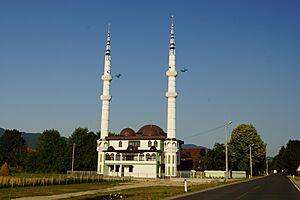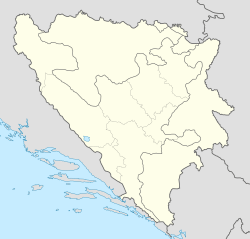Vrbanjci facts for kids
Quick facts for kids
Vrbanjci
Врбањци
|
|
|---|---|
|
Village
|
|
 |
|
| Country | Bosnia and Herzegovina |
| Entity | Republika Srpska |
| Municipality | Kotor Varoš |
Vrbanjci (Serbian Cyrillic: Врбањци) is a village in Bosnia and Herzegovina. It is located in Republika Srpska, within the Municipality of Kotor Varoš.
Contents
Geography of Vrbanjci
Vrbanjci is named after the Vrbanja river, which flows through the village. It is nestled between other rivers like Jezerka, Bosanka, and Cvrcka. The village was once known as Plitska, a name that came from a part of the settlement being near the "Shallow River" (Plitka Rika).
Over time, more people moved to the areas around the Vrbanja river. This happened especially when a narrow-gauge railway and a main road were built, connecting Vrbanjci to places like Šiprage and Maslovare. Until 1964, Vrbanjci was its own separate municipality, which means it had its own local government.
History of Vrbanjci
Early History and Legends
The area around Vrbanjci has a long history. A famous battle took place on The Field of Večići, near the Vrbanja river. This was a clash between the Ottoman army and local Bosnian forces. There's a well-known legend about brave brothers who fought and died there. A special monument, called a turbeh, stands in the village of Večići to remember them. This battle likely happened around 1463, when Bosnia became part of the Ottoman Empire.
Vrbanjci During World War II
During World War II, different groups controlled this area at various times. These included local fighters known as partisans, and German soldiers along with their allies, the Ustasha and Chetniks. In 1942, during one German occupation, all the people from the village of Večići (which is part of the Vrbanjci area) were arrested after two German soldiers were killed nearby. Towards the end of the war, the partisans prepared in this area to free Kotor Varoš, which was one of the last strongholds for the Ustasha forces in Bosnia.
Recent History and Community
During the War in Bosnia (1992–1995), there were difficult times for the people of Vrbanjci and nearby villages. After the war ended in 1995, many people who had left, especially the Bosniak population, returned home. They rebuilt their homes and lives with help from international groups and their own hard work.
Since 1995, parents of Bosniak students at the local "Sveti Sava" Elementary School have been working to ensure their children can learn in their native Bosnian language. After many years, the Constitutional Court of Republika Srpska ruled in their favor in December 2019. This decision confirmed their right and required the school to cover the costs of the court case.
Population of Vrbanjci
This table shows how the population of Vrbanjci has changed over the years, based on different census counts. A census is like a big count of all the people living in an area.
| Census year | 1991 | 1981 | 1971 |
|---|---|---|---|
| Bosniaks | 1.468 (49.34%) | 487 (29.89%) | 514 (31.07%) |
| Croats | 799 (26.85%) | 689 (42.29%) | 651 (39.35%) |
| Serbs | 658 (22.11%) | 373 (22.89%) | 473 (28.59%) |
| Yugoslavians | 41 (1.37%) | 79 (4.84%) | 13 (0.78%) |
| Others and Unknown | 9 (0.30%) | 1 (0.06%) | 3 (0.18%) |
| Total | 2,975 | 1,629 | 1,654 |
Population of Kotor Varoš County, 1953
This table shows the population of the wider Kotor Varoš County in 1953, including Vrbanjci, and the different ethnic groups living there at that time.
| Census area | Total | Serbs | Croats | Slovenians | Macedonians | Crnogorci | Yugoslavs undecided |
Czechs | Poljaci | Resins – Ukrainians |
Other Slavs | Other Non-Slavs |
| KOTOR VAROŠ COUNTY | 37898 | 25008 | 6485 | 4 | 4 | 10 | 6375 | 2 | – | 2 | – | 8 |
| Kotor Varoš | 4715 | 805 | 2640 | 2 | 3 | 6 | 1253 | 1 | – | 1 | – | 4 |
| Maslovare | 4574 | 3966 | 8 | – | – | – | 600 | – | – | – | – | – |
| Preville | 4576 | 3537 | 696 | – | – | – | 342 | – | – | – | – | 1 |
| Skender Vakuf | 7100 | 6566 | 16 | – | – | – | 518 | – | – | – | – | – |
| Šiprage | 7746 | 6036 | 24 | 1 | 1 | – | 1682 | – | – | – | – | 2 |
| Vrbanjci | 4919 | 1678 | 1728 | 1 | – | 4 | 1505 | 1 | – | 1 | – | 1 |
| Zabrđe | 4268 | 2420 | 1373 | – | – | – | 475 | – | – | – | – | – |


